by Winding Pathways | Oct 28, 2021 | (Sub)Urban Homesteading, Flowers/Grasses, Garden/Yard, Garden/Yard, Nature, Trees
A camera is an outstanding tool to see change. Plant a tree or prairie and it grows so glacially slowly that noting change is hard. Photos help by compressing time.
In August 2020 a derecho felled 47 of our 53 mature trees. We spent much of last fall converting them into firewood and piling up brush. Knowing that the land would be sunny after years of leafy shade, we planted a blend of savanna wildflowers last November.
The area didn’t change much from last fall until April of this year. Then nature put on a glorious show. Here are three photos of our yard taken in April, May, and September 2021. Most of the growth didn’t come from the seeds we planted last fall. Seeds long dormant in the soil sprouted with enthusiasm once they sensed the sun’s springtime warmth.
-
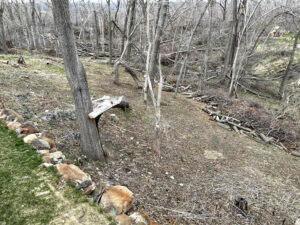
-
For over eight months the land lay waiting and still.
-
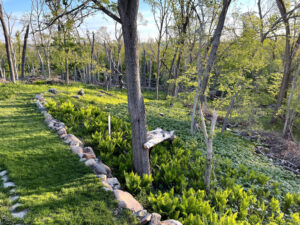
-
Ferns and Mayapple emerged strongly and yielded to more open woodland plants.
-
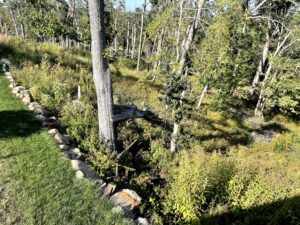
-
The seeds had waited dormant for the right conditions.
by Winding Pathways | Sep 23, 2021 | (Sub)Urban Homesteading, Garden/Yard, Nature, Trees
Coppicing
What? Coppicing? That word almost sounds dirty. Well, it’s not. It is a good way to help derecho doomed trees live on!
We recently hosted friends to mark the first anniversary of the August 10, 2020, furious derecho that leveled around 70% of trees in the Cedar Rapids area.
Many people used words like devastation and destruction to describe what happened to trees in both forests and neighborhoods. The damage was truly shocking.
-
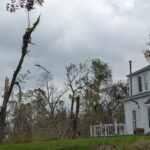
-
Trimming damaged trees.
-
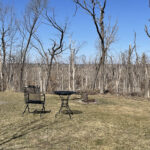
-
All winter we looked on broken trees.
-
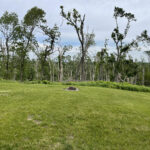
-
Springing Back from Derecho.
The Giving Trees
We wanted to show visitors a miracle of nature stimulated by the storm. Just east of our house stood a couple of basswood trees. Few of nature’s scents are as delightful as what comes from the blooms of this tree. Bees will fly three miles away to gather the nectar. We just enjoy the scent.
Basswoods have a problem. Their wood is soft and weak. When the derecho hit, they quickly snapped off, leaving a tangle of branches in our yard. Nearly a year later they demonstrated the power of near-perpetual youth.
-
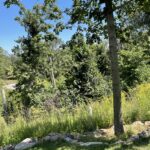
-
In the middle our basswood looks like a fuzzy brush.
-
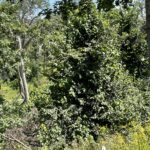
-
This basswood wants to live!
Basswoods, along with many other deciduous trees, readily coppice. If a tree is cut or blown down it sends shoots up from the stump. Our basswoods quickly sprouted this spring, and we’re seeing others sprouting from stumps in suburban yards. Many species of deciduous trees also send up shoots. Ashes, oaks, and honey locusts are common sprouters. Evergreens don’t. If a pine or spruce is cut off, the stump dies.
Woodland Management
In Europe coppicing is a method of woodland management. A tree is cut down and allowed to resprout. Because the regrowth is coming from a well-established root system, sprouts grow like crazy. The sprouts are managed carefully. The most hearty sprout is kept and the others cut off. Within five to twenty years, or so, the hearty sprout is big enough to cut for firewood, fence posts, or walking sticks. Then the stump resprouts again. Some trees have been coppiced for hundreds of years.
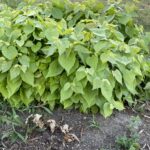
Basswood trees are champion sprouters. Our stumps now look like balls of green leaves from all the sprouts radiating from the stumps. This fall we’ll clip off all but the most vigorous one. It will quickly form a new tree. That’s better, easier and cheaper than grubbing out the stump, then buying and planting a replacement tree.
-
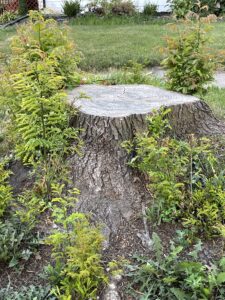
-
The Giving Tree
-
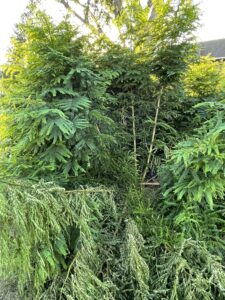
-
A look at the stems of new sprouts
-
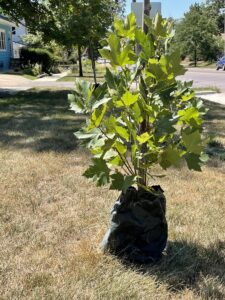
-
the original new tree died, but sprouted from the bottom.
-
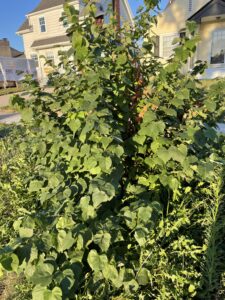
-
Repairs continue as damaged trees sprout.
An Internet search will turn up much information on coppicing. We like the website of the Midwest Permaculture Center.
by Winding Pathways | May 20, 2021 | Nature, Trees
May’s first few weeks are the most delightful time to be outdoors. Warm days combine with the delicious scent of spring. It’s the peak time for birds that wintered far to the south to either settle in to nest or briefly rest and eat before winging further north. Their songs fill the air.
Early May awakens plants, and in early May Rich discovered a treasure. It was an oak sprout that seemed to have “hope” written all over its new soft green leaves.
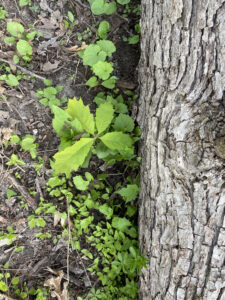
The seedling radiated hope.
Winding Pathways adjoins Faulkes Heritage Woods, an area of sloping land bordered by homes on the south and Indian Creek to the north. Last August 10th a derecho bearing 140 miles an hour wind tore through Iowa. Neither Winding Pathways nor Faulkes Woods was spared. Trees, many of them enormous, either snapped off or uprooted, leaving a scene many called “devastation.”
At first, that seemed like an apt description, and the woods looked ravaged all winter. Rebirth comes with spring. While sitting on a fallen log Rich looked down to see a tiny white oak sprout. It just seemed to say, “Hi, here I am ready to grow.”
Oaks thrive on sunshine, and with big trees now felled on the ground, light floods the soil to energize the leaves of the baby oak and other seedlings. Gradually the old tree will decompose. Its wood will add nutrients to the soil to be appreciated by the youngsters.
Nature has amazing resiliency. One just needs to look to see it.
by Winding Pathways | Mar 25, 2021 | Amphibians/Reptiles, Birds, Bugs, Nature, Trees, Wonderment
Quilting and the Chesapeake Bay
Guest Blogger, Sigrid Reynolds
I have always loved the humble arts of unknown women who pieced quilts. My own attempts at the craft had resulted in exactly 10 squares in the 1980s when I had small children at home who took afternoon naps. At the same time, I started looking through the piles of quilts at antique stores in the Shenandoah Valley. It thrilled me to see the patterns, colors, and precise stitching of women from the past. So seduced was I by these piles, I knew collecting could get out of control. But then I found a Pennsylvania Dutch unquilted top in an original bold tulip design of blue, red, and yellow colors. I decided to seek and purchase only this color combination. That kept the lid on it since these colors are rare in combination.
COVID-19 Quilting
Taking up quilting again didn’t occur to me until Spring 2020 when I was asked to join a young friend’s virtual pandemic quilt circle. In a time when we all faced our own mortality and the uncertain path the pandemic and the nation would take, we needed something to calm ourselves. As a retired person, I had nothing filling my time and frankly, felt the need to leave some little part of me behind in the lives of my descendants.
The group chose a striking geometric pattern with many triangular pieces. I purchased material, cut a few triangles, and then I went rogue. My inclination was to go faster, larger and more personal since I’d found piecing tedious in those earlier tries. Besides, I am 30 years older than the members in my group so my “life” time is more limited. I found purpose in a multi-generational family vacation home on the Chesapeake Bay just begging for Aunt Sig artifacts for posterity.
A “Fishy” Quilting Inspiration
My first quilt was a re-interpretation of a fish painting that the family had owned for 90 years. The family has always asked guests to tell them how many fish they see in the painting. So, I added goldfish for a humorous twist and quilted in additional fish. In all, there are 40 fish in this quilt.
-
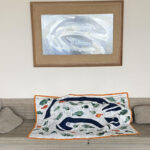
-
A humorous adaptation of the family fish painting.
-
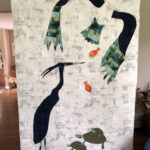
-
Remembering sunning turtles.
What came next was an urge to recognize the other birds and animals seen regularly on or near the Bay: herons in the morning and evening along with osprey all day. And then I was remembering sunning turtles in a nearby spring-fed pond. I added more goldfish and quilt fish to keep the puzzle going.
I next needed to represent the loblolly pines that line the shores of that estuary. And, of course, I needed additional visitors: raccoons, foxes, and box turtles. While quilting, I added one ghostly possum in the lower right-hand corner. And why not add some quilted poison ivy since that is always an island hazard? And yes, there are fish quilted into the water to count.
-

-
The beginnings of a personal quilt.
-
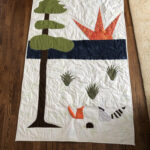
-
Capturing the sunrise
New Inspirations
Finally, as this quiet, worrisome time comes to an end, I realized that I needed to turn from nature to hail the Baltimore Light, a caisson lighthouse, that has defined the deep channel for ships going into Baltimore Harbor my entire life. Since it was winter, I recalled the two times that I had seen the Bay had frozen and decided that might be a good subject. And yes, there will be quilted fish to count under the ice floes.
Nature Continues to Inspire
I have pondered what prompts this late-in-life creativity and conclude that the pandemic opened up a fertile field in me that might have remained fallow. I, like many, turned to the nearby nature of our backyard and parks but memories of a barefoot childhood on the Bay persisted. Quilting allowed me to visit the nature of my memories.


by Winding Pathways | Dec 17, 2020 | (Sub)Urban Homesteading, Garden/Yard, Geology/Weather, Nature, Trees
We won’t forget August 10, 2020. On that summer day, Cedar Rapids was hit with 140 miles an hour winds that tore off roofs, felled signs, and toppled at least 65% of the City’s trees. The damage was awesome.
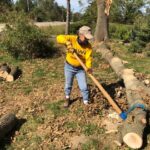 We lost 47 of our 53 big trees at Winding Pathways and spent the next two months cutting up a twisted jumble of trunks and branches. We bucked up what we could for firewood and made huge brush piles on the north end of our property for wildlife habitat. We used chain saws for cutting but muscle power to haul brush and wood.
We lost 47 of our 53 big trees at Winding Pathways and spent the next two months cutting up a twisted jumble of trunks and branches. We bucked up what we could for firewood and made huge brush piles on the north end of our property for wildlife habitat. We used chain saws for cutting but muscle power to haul brush and wood.
Nearly all woodland owners suffered similar damage, and most of them immediately began clearing away broken and downed trees. Some used heavy equipment to haul off debris, leaving bare soil in the woods, a perfect seedbed for weeds.
Resetting the Forest
The derecho reset Iowa’s woods. Prior to settlement most of the state was prairie with woodlands typically lining streams and rivers. Frequent wildfires raced through grasslands and never hesitated when they encountered woods. This created a savanna ecotype characterized by scattered fire-resistant big trees, mostly oaks, walnuts, and hickories, with a stunningly diverse array of wildflowers carpeting the ground.
Savanna was an “open” forest. It lacked a shrub understory, and because trees didn’t create a closed leafy canopy sunlight dappled the ground. Perhaps no forest is as beautiful or endangered as savanna.
Iowa’s settlers quickly suppressed fire. Gradually trees closed the canopy, keeping the ground in shade most of the day. Many savanna flowers need some sunlight and declined as a shrub layer, often of exotic invasive woody plants, thrived. Many woods that owners considered healthy were actually degraded by years of fire protection.
The derecho changed it within under an hour. Many trees fell to the ground, but others survived. Woodlands will now have sunlight reach the ground, stimulating both invasive species and long-suppressed native wildflowers.
Planning and Planting
The woods on the east side of our house created nearly a complete canopy, but suddenly they fell. After we cleared away the debris, we did these things:
- Planted a few white and bur oaks in the fall. We’ll plant a few more next spring. All are protected from deer browsing with a stout ring of wire mesh.
- Purchased a diverse mix of savanna wildflowers and a few kinds of grass from Pheasants Forever. Mid-November brought two inches of new snow, and we hustled out to broadcast the seeds on it. It’s called frost planting and works well.
- Discovered some tiny oaks, hackberries, and walnuts amid fallen trees. We marked them and know they’ll grow rapidly next year.
Recovery will be slow. Newly planted trees grow slowly their first few years and savanna and prairie seeds take a few years to establish. We don’t expect to see much change in 2021 but our “new” savanna will eventually be gorgeous and look much like it would have in the early 1800s.
Sources
We bought our prairie seed from www.pheasantsforever.org. Our fall-planted trees were ordered from the National Arbor Day Foundation www.arborday.org. Spring planting will be of trees we bought from Chief River Nursery www.chief rivernursery.com.
-

-
Trimming damaged trees.
-
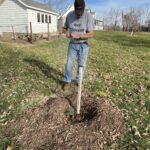
-
Arbor Day in November
-
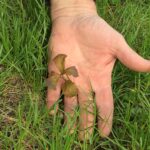
-
Discovering volunteer seedlings
-
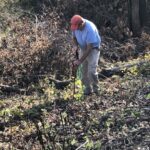
-
Rich planting acorns gleaned from an undamaged timber patch
We’ll follow up our planting with occasional prescribed burns to retard invasive plants and invigorate natives.
by Winding Pathways | Dec 10, 2020 | (Sub)Urban Homesteading, Garden/Yard, Nature, Trees, Trees/Shrubs
Unusual Storm Clouds
The August storm looked like an ordinary thunderstorm approaching. Dark clouds gathered to the west as we sat on our porch. What happened minutes later was far from normal.
The roaring wind hit like a prize fighter’s fist, bending our small oaks and maples parallel to the ground. Before it struck, we had 53 mature, healthy trees on our two acres. Forty minutes later only six still stood somewhat unravaged. As we watched in dismay and horror our oaks, hackberries, cherries, pines, and Douglas Firs either uprooted or snapped off. At least our beloved black walnut still stood on the edge of the woods.
Then a massive gust later reported to be 140 miles an hour by the National Weather Service, stripped off the walnut’s branches. Soon, the wind calmed, allowing us to see tree carnage and home damage. It was shocking and started three months of clean up and reconstruction. We fixed the house but it’s not possible to replace century-old trees.
A Banner Day
In contrast to the August 10, 2020 derecho, Thursday, November 19 was a banner day.

Arbor Day in November
We had just received a box of trees from the National Arbor Day Foundation. After we tucked the oaks, maples, pines, and aspens into the ground we ringed them with a thick layer of wood chips and gave them a good drink of water. The chips came from massive fallen trees the City of Cedar Rapids ground up after the storm. Then we circled each tree with wire mesh to protect it from hungry deer. By afternoon we were tired but elated. We won’t live long enough to see our new trees as giants, but we gave them a good start.
Arbor Day Quality Trees
The baby trees looked great. It was our most recent purchase from the Arbor Day Foundation. Although inexpensive, they looked healthy and eager to grow. Even the bur and white oaks, which have robust and long taproots looked great.
In most places, Arbor Day is celebrated in late April. We’ll plant some more trees then, but we sat on our back deck on a warm November evening and enjoyed seeing our trees in their new homes. For us and our new trees, it was Arbor Day in November.
Lied Lodge and Arbor Day Foundation – Destination
We have visited the Arbor Day Foundation in Nebraska City, Nebraska, several times. It’s where Arbor Day was created. We’ve overnighted at Lied Lodge on the property and enjoyed walking trails on Arbor Day Farm.
So, if you need to buy trees check out arborday.org. Want a pleasant place to visit? The Farm and Lodge are less than an hour’s drive south of Omaha. Although we’ve been there several times, we look forward to returning.



















 We lost 47 of our 53 big trees at Winding Pathways and spent the next two months cutting up a twisted jumble of trunks and branches. We bucked up what we could for firewood and made huge brush piles on the north end of our property for wildlife habitat. We used chain saws for cutting but muscle power to haul brush and wood.
We lost 47 of our 53 big trees at Winding Pathways and spent the next two months cutting up a twisted jumble of trunks and branches. We bucked up what we could for firewood and made huge brush piles on the north end of our property for wildlife habitat. We used chain saws for cutting but muscle power to haul brush and wood.

